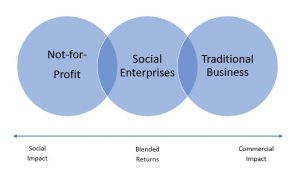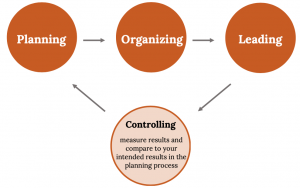The Management Process
Consider this scenario: you’re halfway through the semester and ready for midterms. You open your class notes and declare them “pathetic.” You regret scribbling everything so carelessly and skipping class so many times. That’s when it hits you: what if there was a note-taking service on campus? When you were ready to study for a big test, you could buy complete and legible class notes. You’ve heard that there are class-notes services at some larger schools, but there’s no such thing on your campus. So you ask yourself, why don’t I start a note-taking business? Your upcoming set of exams may not be salvageable, but after that, you’d always have great notes. And in the process, you could learn how to manage a business (isn’t that what majoring in business is all about?).
You might begin by hiring a bunch of students to take class notes. Then the note-takers will e-mail them to your assistant, who’ll get them copied (on a special type of paper that can’t be duplicated). The last step will be assembling packages of notes and, of course, selling them. You decide to name your company “Notes-4-You.”

It sounds like a great idea, but you’re troubled by one question: why does this business need you? Do the note-takers need a boss? Couldn’t they just sell the notes themselves? This process could work, but it would work better if there was someone to oversee the operations: a manager—to make sure that the operations involved in preparing and selling notes were performed in both an effective and an efficient manner. You’d make the process effective by ensuring that the right things got done and that they all contributed to the success of the enterprise. You’d make the process efficient by ensuring that activities were performed in the right way and used the fewest possible resources.
What Do Managers Do?
The Management Process
The effective performance of your business will require solid management: the process of planning, organizing, leading and controlling resources to achieve specific goals.

Organizational goals are dependent on the type of organization. There are many models but in this text, we will explore the three major models depicted in the graph above: Not-for-Profit, social enterprises, and traditional. A not-for-profit organization’s core purpose is social advancement. This type of organization generates revenue through grants and/or donations vs through business activities (selling products or services). Examples of not-for-profits would include the Canadian Red Cross, United Way, and the Salvation Army. Social enterprises have blended purpose. This model of business is dedicated to a specific social mission and generates for-profit revenue through selling products or services with the goal of reinvesting a portion of its profits into achieving that mission. The shoe company, TOMS, is an example of a social enterprise; the company’s Shoe for Shoe program ensures that for every pair of shoes you buy from them, they will donate an adequate pair to a child in need. Lastly, a traditional business’s core purpose is for-profit revenue generation, created through selling products or services. Its primary goal is to maximize profits for the business owners and/or stakeholders. Apple and Mcdonald’s are internationally known organizations that operate through this model. So, how managers apply POLC depends on the organization’s model. Let’s get back to POLC.
A plan enables you to take your business concept beyond the idea stage. It does not, however, get the work done. For that to happen, you have to organize things effectively. You’ll have to put people and other resources in place to make things happen. And because your note-taking venture is supposed to be better off with you in charge, you need to be a leader who can motivate your people to do well. Finally, to know whether things are in fact going well, you’ll have to control your operations—that is, measure the results and compare them with the results that you laid out in your plan. Figure 2 summarizes the interrelationship between planning and the other functions that managers perform. This chapter will explore planning, leading, and controlling in some detail. Organizing is an especially complex topic and will be discussed in the next chapter. At this stage of your learning consider organizing as the way a business structures itself to accomplish its plan including who reports to who and does what?

These four words – PLANNING – ORGANIZING – LEADING – CONTROLLING form the management process. You might refer to them as steps, some people refer to them as elements or components, there are different labels used for them but one thing is clear – they are the core of management. The remaining chapters of this text describe POLC – one big important thing you’ll want to remember from this course!
Attribution
Section on The Management Process is reproduced from Chapter 8 in Fundamentals of Business, 3rd edition by Stephen Skripak with Ron Poff licensed under a Creative Commons Attribution-NonCommercial-ShareAlike 4.0 International License.

